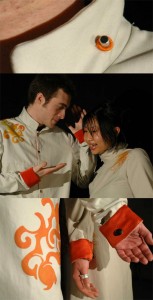When I am asked, as often happens both at conferences and informal gatherings, to predict the future of “smart textiles” and wearable technologies, I feel overwhelmed by the breadth of the field and often resort to humour and sarcasm.When I am asked, as often happens both at conferences and informal gatherings, to predict the future of “smart textiles” and wearable technologies, I feel overwhelmed by the breadth of the field and often resort to humour and sarcasm. When I was still a graduate student at the MIT Media Lab, I would answer that we were hard at work on jetpack technologies, the 21st century version of the flying carpet. I would elaborate that this innovation of the future will involve fast personal transportation; physically getting us from place to place in the minimum amount of time and in maximum comfort. I always said this tongue-in-cheek of course, but deep down, I believed that the whole point of making a technology wearable was to make it (a) individual (for a single user), (b) comfortable and (c) efficient. So perhaps brand-name jetpacks were not such a preposterous suggestion after all.
My predictions were put to the test when the Segway Personal Transporter was introduced five years later. It claimed to herald a breakthrough in “moving you easily, efficiently, intelligently and simply”, but was not an immediate commercial success due to its $5000 price tag (among other reasons). Of course, the Segway is not textile-based and strictly speaking not a wearable technology, but it approximates the jetpack. We could compare it to a pair of futuristic shoes that double as a street-surfing device. It also meets my three criteria, that of individuality, comfort, and efficiency. Perhaps it was just too far ahead of its time. Sale estimates (since the company refuses to release official sales figures) have increased substantially in recent months, correlated to increases in fuel price.

The "Constallation Dresses" are covered with magnetic snaps and a decorative LED pattern that can only be illuminated when other dresses are nearby.
But, back to the original questions; What is the future of “smart textiles” and wearable technologies? What products will be the first to make it onto the mass market? What will be the first truly successful product, appealing to more than just early adopters? I often say that the future of wearable technologies is already here, but it is invisible and slightly boring, since it is coming in incremental steps instead of with a bang. In other words (the words of others), the future of wearable technology is already here but not well distributed yet. There are obvious applications in health, wellness, sports, and performance products, often involving biometric monitoring and tracking applications. There is obvious interest from the military industry, consumer electronics companies such as Philips, and in fashion designers such as Hussein Chalayan. The problem is that nobody quite knows yet how to reach a broader consumer base.
This brings me back to my deep belief that the only reason to make a technology soft and wearable (other than to take advantage of fads or fashions) is because it will allow us to do something more efficiently, in more comfort, and (physically) alone. A wearable technology can be customized to be truly individual; it is ultimately portable; it can be used (and misused) in private; and ultimately will allow us do the things we like to do in certain places and with certain people, while in different locations.

The SMOKS are a pair of electronically enhanced suits that use fashion and our interactions through clothing to accumulate and display traces of physical memory in personal and playful ways.
As such, in all seriousness this time, I predict that the future of wearable technologies is deeply centered in the social and cultural sphere. The future of “smart textiles” is to do what “dumb textiles” have been doing (with incredible success) for generations, but to do it remotely and perhaps in seclusion. “Dumb textiles” have been very successful throughout history and across different cultures in communicating many (both subtle and overt) aspects of our personal and cultural identity. “We have learned to use garments effectively to hide, reveal, and distort the self that we present to the world. We use fashion to express social, cultural, economic, religious, sexual, and professional aspects of our identity, among others [2].” Garments “also collect and reflect some of our most intimate moments and are marked by our sweat, food stains and tears [1].”
I predict that social networking technologies (which were traditionally on the body in the form of garments and decorations) are ready to move back onto the body. Social networking companies such as Flickr, Blogger, YouTube, Facebook, and MySpace need to start investing in “smart textiles” as the next staging area for their applications. Garments will soon become the new playground for digital social networking technologies, as software slowly seeps off mobile phones and into illuminated zippers that display when you have been “poked” on Facebook; flowers that open and close to reveal the status of your social relationships; or furry spots that appear when a new post has been uploaded. The future is social. We want to know when our friends are thinking about us and we want to show this information to those around us. We want to show off our social networks in the same way we like to show off brand names and labels. We want to integrate some of our networked personas back into our physical reality.
I deeply believe that the winning application will not involve reading email on my sleeve, increasing my productivity by receiving vibrating reminders of my appointments in my jacket, or keeping track of my calorie intake through my necklace. Those are specialized applications. They are not fun or sexy. They sound too much like work. The future of “smart textiles” and wearable technologies is to have fun, to connect with friends, and to bring social networking information back onto the body.
Joanna Berzowska
Joanna Berzowska is the founder and research director of XS Labs, a design research studio that develops innovative methods and applications in electronic textiles and responsive garments. She is Associate Professor of Design and Computation Arts at Concordia University and a member of the Hexagram Research Institute in Montreal. She lectures and consults internationally about the field of electronic textiles and related social, cultural, aesthetic, and political issues. Her art and design work has been shown in the Cooper-Hewitt Design Museum in NYC, the V&A in London, the Millenium Museum in Beijing, SIGGRAPH, ISEA, the Art Directors Club in NYC, the Australian Museum in Sydney, NTT ICC in Tokyo, and Ars Electronica Center in Linz among others. Her research is supported by the Canada Council for the Arts, the Canada Foundation for Innovation (CFI), the Social Sciences and Humanities Research Council of Canada (SSHRC), Canadian Heritage, Hexagram Institute for Research/Creation in Media Arts and Technologies, and the Fonds québécois de recherche sur la société et la culture (FQRSC). She was recently selected for the Maclean’s 2006 Honour Roll as one of “thirty nine Canadians who make the world a better place to live in.
References
[1] Berzowska, J. “Memory Rich Clothing: Second Skins that Communicate Physical Memory”, Proceedings of 5th Conference on Creativity & Cognition, ACM Press, New York, 2005, pp. 32 – 40.
[2] Berzowska, J. “Electronic Textiles”, Textile, Berg, London, 2005, Volume 3, Issue 1, pp. 2–19.
Read More
 This work is licensed under a Creative Commons Attribution-NonCommercial-ShareAlike 2.5 Australia.
This work is licensed under a Creative Commons Attribution-NonCommercial-ShareAlike 2.5 Australia.







[...] and demonstrated what facilitator Joanna Berzowska called a “third wave” in the field of wearable technology, which she stated was a new development. In this “third wave”, the conceptual resolve and use [...]